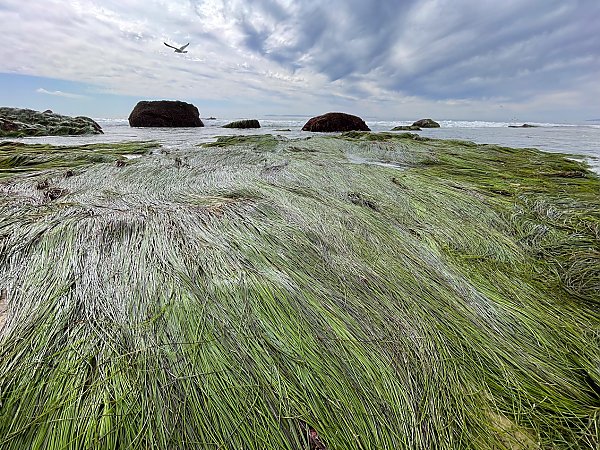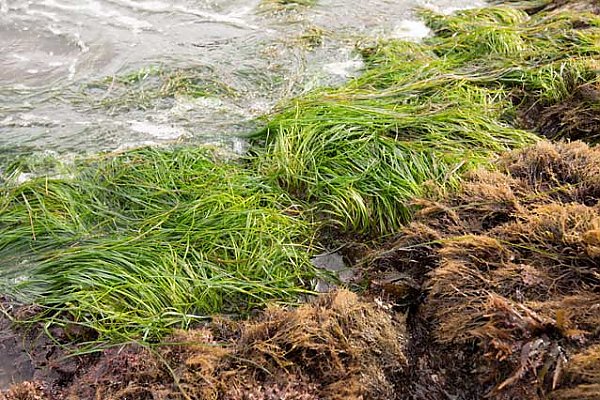Surfgrass
Phyllospadix spp.
Surfgrass
Phyllospadix spp.
Morphology
Two main surfgrass species are found along the California coast: Phyllospadix scouleri and Phyllospadix torreyi. Here we lump the two species together when discussing their status and trends because field monitoring programs tend to lump them together when collecting data. From an ecosystem perspective, lumping the two surfgrass species together makes sense because they both perform the same important ecological functions.
California surfgrass grows in large clumps or beds, often forming dense mats that are exposed during low tide and submerged at high tide. Unlike other seagrasses that grow in softer substrates, surfgrass roots are adapted to rocky environments, with enhanced hypodermal fiber and root hair development. This adaptation is essential for survival in high-energy wave environments. Surfgrass also has rhizomes (underground stems) that aid roots in anchoring the plant, but also store nutrients, and maintain vegetative growth.
Habitat and Range
Although both of our surfgrass species overlap entirely throughout California, they have different ranges outside of California. Phyllospadix scouleri extends from Sitka, Alaska to Baja California, Mexico. Phyllospadix torreyi ranges from Vancouver Island, Canada to Baja California, Mexico. Surfgrass grows in tidepools or in clumps or beds in the low intertidal zone.
Range Map
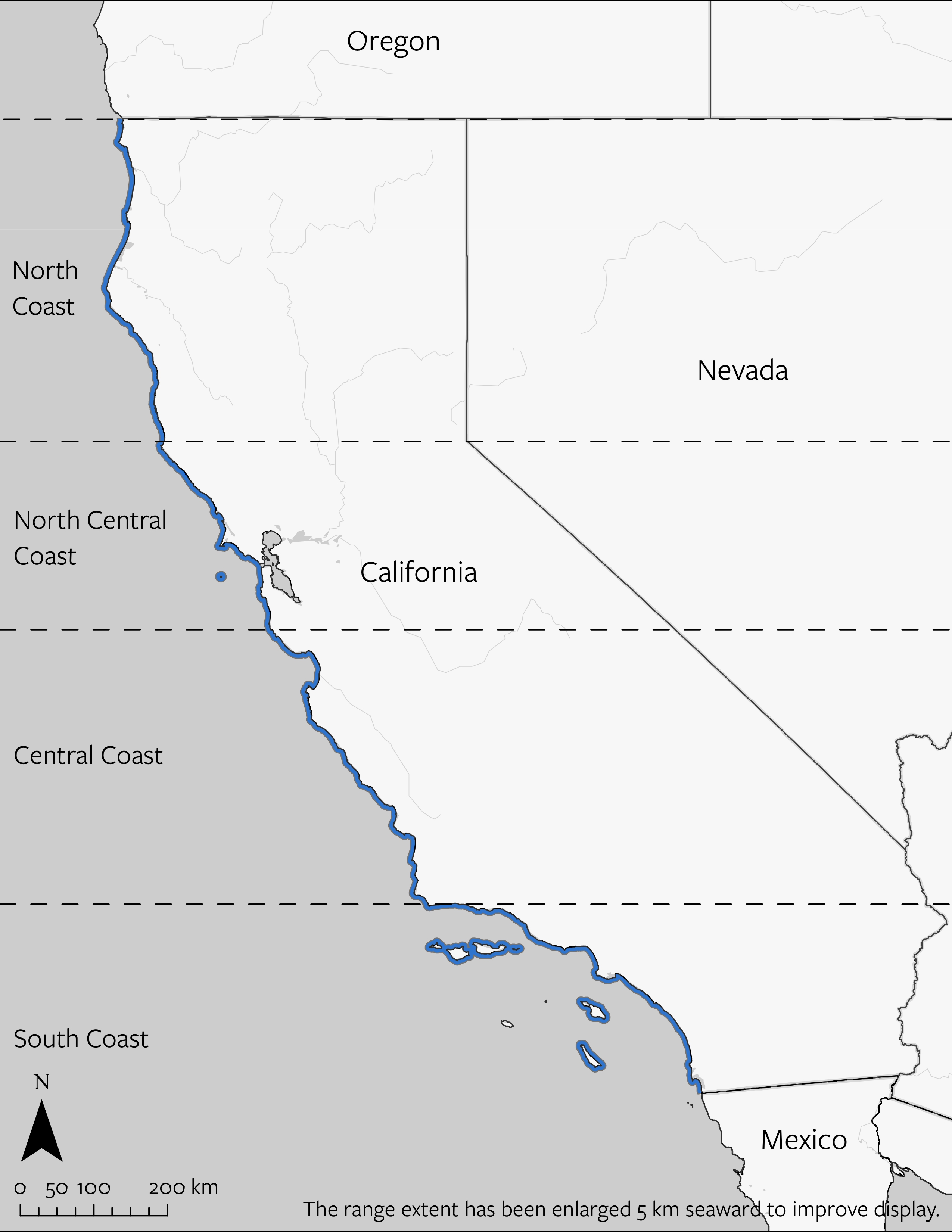
Reproductive Biology and Life History
Male and female flowers are borne on different plants, with more female than male plants. Surfgrass can pollinate both underwater and at the ocean’s surface. This fertilization involves the transport of pollen by water currents. The male flowers produce thread-like pollen that is negatively buoyant, allowing it to sink and be carried by water currents to female flowers. Surfgrass seeds can be dispersed over considerable distances, which allows surfgrass to colonize new areas effectively.
Ecology
Surfgrass beds support diverse marine life, including invertebrates, juvenile fish, and epiphytic algae. They act as nursery grounds for commercially important species like the California spiny lobster. They improve water clarity by filtering water and trapping sediments. They help stabilize shorelines and reduce erosion. Seagrass is remarkably efficient at storing carbon in the sediments and roots beneath them. They can store up to 83,000 metric tons of carbon per square kilometer, which is more than a typical terrestrial forest that stores 30,000 metric tons of carbon, mostly in the form of wood.
Cultural and Historical Context
Cultural uses of surfgrass are not well-documented. Seagrasses in general have been utilized by indigenous and coastal communities globally for building materials, weaving, and cordage, as well as incorporating seeds or rhizomes into medicinal tonic. However evidence regarding surfgrass uses among indigenous communities in California in particular is lacking.
Because of its ability to sequester carbon, surfgrass restoration and protection is attracting investment in what are called “blue carbon markets”. Blue carbon markets are platforms for trading carbon credits generated from coastal and marine ecosystems such as mangroves, seagrasses, and salt marshes. The implementation of blue carbon markets is currently hindered by large spatial variability among seagrass sites and difficulty in establishing pragmatic protocols for verifying carbon storage in the field.
Date modified: January 2025
This algae can be found at the Aquarium of the Pacific
Primary ThreatsPrimary Threats Conditions
Threats and Conservation Status
Human activities have historically impacted surfgrass through pollution, coastal development, and invasive species. Studies in the Monterey Bay National Marine Sanctuary documented the effects of a small domestic sewage outfall on surfgrass meadows. The discharge, which included toxic substances like chlorine, led to a significant reduction in surfgrass cover. However, after the termination of sewage discharge, the surfgrass showed a capacity for recovery, indicating resilience once the stressor was removed. Coastal development poses a threat to surfgrass habitats by altering natural landscapes and increasing sedimentation and runoff. In spite of these threats, surfgrass populations appear to be weakly increasing and have repeatedly shown the ability to recover from local degradation.
Surfgrass is monitored by recording “% cover” in quadrats in surfgrass habitats. If the data are averaged across all four regions, the trend is weakly increasing with a less than 1% increase per year. There are, however, regional differences. The Central, North Central, and North regions all show stable surfgrass populations. In contrast, there is indication of a weak increase in percent cover of 2.05% per year in the South Coast region.
Community science has contributed significantly to surfgrass conservation. In the Monterey Bay National Marine Sanctuary, surfgrass meadows have been monitored over a period of 42 years by community scientists. This long-term monitoring has provided valuable data on the resilience of surfgrass communities to disturbances such as sewage discharge. The findings indicate that surfgrass communities can recover over time, demonstrating resilience to environmental changes.
Population Plots


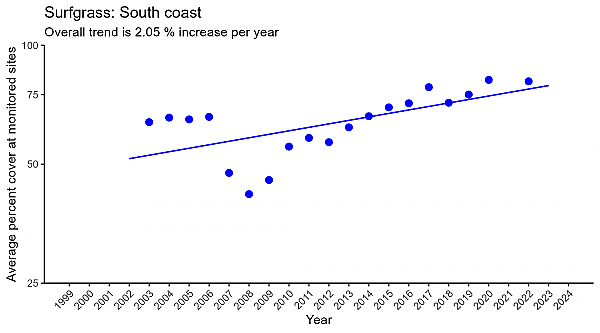
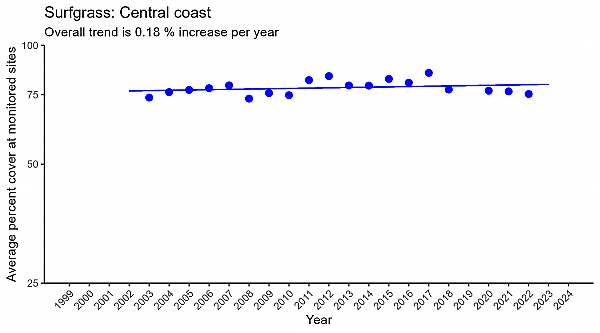


Data Source: The data were obtained from MARINe rocky intertidal sampling locations (see https://marine.ucsc.edu/). The MARINe Network website describes the sampling protocol.

